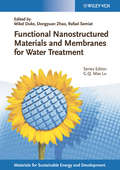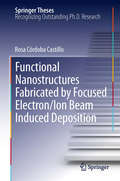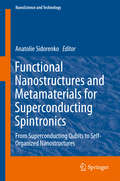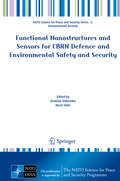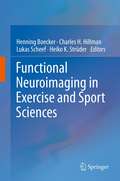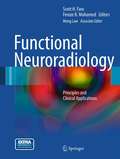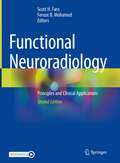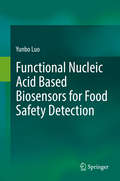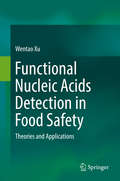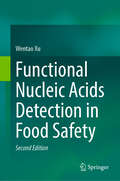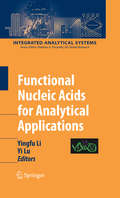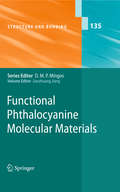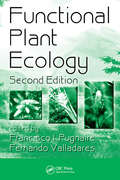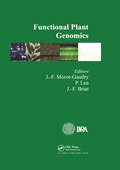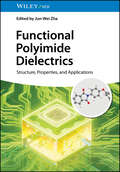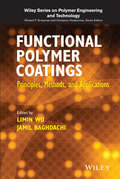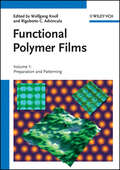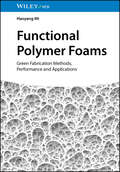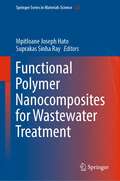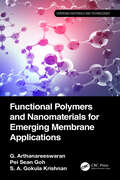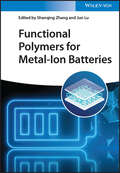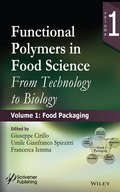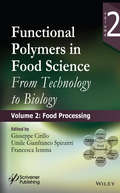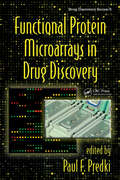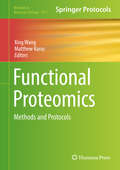- Table View
- List View
Functional Nanostructured Materials and Membranes for Water Treatment
by Max Lu Dongyuan Zhao Mikel Duke Rafael SemiatMembranes have emerged over the last 30 years as a viable water treatment technology. Earth's population is growing and the need for alternative ways to generate potable water is rising. The recent advent of nanotechnology opens the door to improving processes in membranetechnology, which is a promising step on the way to solving the earth's potable water problem. Current performance is enhanced and new concepts are possible by engineering on the nanoscale. This book presents key areas of nanotechnology such as fouling tolerant and robust membranes, enhanced destruction of pollutants and faster monitoring of water quality.'Functional Nanostructured Materials and Membranes for Water Treatment' is part of the series on Materials for Sustainable Energy and Development edited by Prof. G.Q. Max Lu. The series covers advances in materials science and innovation for renewable energy, clean use of fossil energy, and greenhouse gas mitigation and associated environmental technologies.
Functional Nanostructures Fabricated by Focused Electron/Ion Beam Induced Deposition
by Rosa Córdoba CastilloThis thesis constitutes a detailed study of functional nanostructures (ferromagnetic, superconducting, metallic and semiconducting) fabricated by focused electron/ion beam induced deposition techniques. The nanostructures were grown using different precursor materials such as Co2(CO)8, Fe2(CO)9, W(CO)6, (CH3)3Pt(CpCH3) and were characterized by a wide range of techniques. This work reports results obtained for the morphology, the microstructure, the composition, the electrical transport mechanism, magnetic and superconducting properties of nanostructures. The results offers exciting prospects in a wide range of applications in nanotechnology and condensed matter physics.
Functional Nanostructures and Metamaterials for Superconducting Spintronics: From Superconducting Qubits to Self-Organized Nanostructures (NanoScience and Technology)
by Anatolie SidorenkoThis book demonstrates how the new phenomena in the nanometer scale serve as the basis for the invention and development of novel nanoelectronic devices and how they are used for engineering nanostructures and metamaterials with unusual properties. It discusses topics such as superconducting spin-valve effect and thermal spin transport, which are important for developing spintronics; fabrication of nanostructures from antagonistic materials like ferromagnets and superconductors, which lead to a novel non-conventional FFLO-superconducting state; calculations of functional nanostructures with an exotic triplet superconductivity, which are the basis for novel nanoelectronic devices, such as superconducting spin valve, thin-film superconducting quantum interference devices (SQUIDs) and memory-elements (MRAM). Starting with theoretical chapters about triplet superconductivity, the book then introduces new ideas and approaches in the fundamentals of superconducting electronics. It presents various quantum devices based on the new theoretical approaches, demonstrating the enormous potential of the electronics of 21st century - spintronics. The book is useful for a broad audience, including researchers, engineers, PhD graduates, students and others wanting to gain insights into the frontiers of nanoscience.
Functional Nanostructures and Sensors for CBRN Defence and Environmental Safety and Security (NATO Science for Peace and Security Series C: Environmental Security)
by Anatolie Sidorenko Horst HahnOver the last decade, techniques for materials preparation and processing at nanometer scale have advanced rapidly, leading to the introduction of novel principles for a new generation of sensors and detectors. At the same time, the chemical industry, transport and agriculture produce huge amounts of dangerous waste gases and liquids, leading to soil, air and water contamination. One more modern threat - international terrorism - demands that scientists make efforts to apply new principles and technologies to protect society against chemical, biological, radiological and nuclear (CBRN) attacks and to develop novel effective technologies for the remediation of large contaminated areas. Accordingly, the main goal of this book is to bring together experts (theorists, experimentalists, engineers and technologists) for an extensive discussion covering: novel principles for functional nanostructures and detector fabrication and implementation, the development of novel technologies for the deactivation of CBRN agents, their experimental realization and their application in novel monitoring and control systems, and technological processes for soil and water remediation, with a view to environmental protection and defence against CBRN-based terrorism. In keeping with the book’s main goal, the following topics are highlighted and discussed: - Sensors and detectors - detection of chemicals, principles of “artificial nose” and chemical “micro-lab on a chip” design, surface and underground water quality monitoring systems, molecular electronics, superconducting electronic devices, quantum detectors and Qubits. - Environmental protection and CBRN - detection of infrared, microwave, X-ray and terahertz radiation. Principles for novel IR-, UV-, and Terahertz-wave devices for the detection of low-contrast objects. - Novel technological processes for CBRN destruction and deactivation. All these topics are strongly interrelated, both with regard to fundamental aspects and to fabrication and implementation technologies; in addition, they are highly promising for application in novel functional devices, computer logics, sensing and detection of low-concentration chemicals, weak and extremely weak magnetic and microwave fields, infrared and ultraviolet radiation. Given its scope, the book will be a useful and interesting guide for a broad readership of engineers, scientists, PhD students and experts in the area of defence against environmental terrorism.
Functional Neuroimaging in Exercise and Sport Sciences
by Charles H. Hillman Henning Boecker Lukas Scheef Heiko K. StrüderRegular physical exercise is associated with substantial health benefits. Recent evidence not only holds for cardiovascular effects promoting "physical health", but also for the central nervous system believed to promote "brain health". Moderate physical exercise has been found to improve learning, memory, and attentional processing, with recent research indicating that neuroprotective mechanisms and associated plasticity in brain structure and function also benefit. Physical exercise is also known to induce a range of acute or sustained psychophysiological effects, among these mood elevation, stress reduction, anxiolysis, and hypoalgesia. Today, modern functional neuroimaging techniques afford direct measurement of the acute and chronic relation of physical exercise on the human brain, as well as the correlation of the derived physiological in vivo signals with behavioral outcomes recorded during and after exercise. A wide range of imaging techniques have been applied to human exercise research, ranging from electroencephalography (EEG), magnetoencephalography (MEG), near infrared spectroscopy (NIRS), magnetic resonance imaging (MRI) to positron emission tomography (PET). All of these imaging methods provide distinct information, and they differ considerably in terms of spatial and temporal resolution, availability, cost, and associated risks. However, from a "multimodal imaging" perspective, neuroimaging provides an unprecedented potential to unravel the neurobiology of human exercise, covering a wide spectrum ranging from structural plasticity in gray and white matter, network dynamics, global and regional perfusion, evoked neuronal responses to the quantification of neurotransmitter release. The aim of this book is to provide the current state of the human neuroimaging literature in the emerging field of the neurobiological exercise sciences and to outline future applications and directions of research.
Functional Neuroradiology
by Feroze B. Mohamed Scott H. Faro John T. Ulmer Meng LawFunctional Neuroradiology: Principles and Clinical Applications, is a follow-up to Faro and Mohamed's groundbreaking work, Functional (BOLD)MRI: Basic Principles and Clinical Applications. This new 49 chapter textbook is comprehensive and offers a complete introduction to the state-of-the-art functional imaging in Neuroradiology, including the physical principles and clinical applications of Diffusion, Perfusion, Permeability, MR spectroscopy, Positron Emission Tomography, BOLD fMRI and Diffusion Tensor Imaging. With chapters written by internationally distinguished neuroradiologists, neurologists, psychiatrists, cognitive neuroscientists, and physicists, Functional Neuroradiology is divided into 9 major sections, including: Physical principles of all key functional techniques, Lesion characterization using Diffusion, Perfusion, Permeability, MR spectroscopy, and Positron Emission Tomography, an overview of BOLD fMRI physical principles and key concepts, including scanning methodologies, experimental research design, data analysis, and functional connectivity, Eloquent Cortex and White matter localization using BOLD fMRI and Diffusion Tensor Imaging, Clinical applications of BOLD fMRI in Neurosurgery, Neurology, Psychiatry, Neuropsychology, and Neuropharmacology, Multi-modality functional Neuroradiology, Beyond Proton Imaging, Functional spine and CSF imaging, a full-color Neuroanatomical Brain atlas of eloquent cortex and key white matter tracts and BOLD fMRI paradigms. By offering readers a complete overview of functional imaging modalities and techniques currently used in patient diagnosis and management, as well as emerging technology, Functional Neuroradiology is a vital information source for physicians and cognitive neuroscientists involved in daily practice and research.
Functional Neuroradiology: Principles and Clinical Applications
by Feroze B. Mohamed Scott H. FaroThis new edition fully updates and expands Faro and Mohamed’s Functional Neuroradiology, a gold standard, comprehensive introduction to the state-of-the-art functional imaging in neuroradiology, including the physical principles and clinical applications of Diffusion, Perfusion, Permeability, MR spectroscopy, Positron Emission Tomography, BOLD fMRI and Diffusion Tensor Imaging. With chapters written by internationally distinguished neuroradiologists, neurologists, psychiatrists, cognitive neuroscientists, and physicists, Functional Neuroradiology is divided into 12 major sections, including: Diffusion and Perfusion Imaging, Magnetic Resonance Spectroscopy and Chemical Exchange Saturation Transfer Imaging, Multi-Modality Functional Neuroradiology, BOLD Functional MRI, Diffusion Tensor Imaging, Presurgical Brain Tumor Mapping, Emerging neuroimaging techniques, Functional Spine and Hydrocephalus imaging, and Neuroanatomical Gray and White matter Brain Atlases. This second edition is fully updated throughout and includes more than 15 new chapters on topics such as: Brain tumor Radiogenomics, CNS Tumor Surveillance and Functional MR Perfusion Imaging, CNS Machine Learning, Focused Ultrasound therapy, TBI Sports Related Injury, and CNS Lymphatic system. By offering readers a complete overview of functional imaging modalities and techniques currently used in patient diagnosis and management, as well as emerging technology, Functional Neuroradiology is a vital information source for physicians and cognitive neuroscientists involved in daily practice and research.
Functional Nucleic Acid Based Biosensors for Food Safety Detection
by Yunbo LuoThis book highlights the development of a functional nucleic acid based biosensor detection method in the context of food safety. Although there have been major advances in food processing technology in both developed and developing countries, food safety assurance systems are generally becoming more stringent, in response to growing (both real and perceived) food safety problems. These problems are due in part to foodborne microorganisms, heavy metals, and small chemical molecules (biological toxins, pesticide residues, and veterinary drug residues), etc. In addition, the nucleic acid biomarkers (DNA methylation, microRNA, and circRNA) induced by these risk factors are also closely related to food safety. Accordingly, this book offers a brief guide to targets and strategies in functional nucleic acid based biosensors for food safety detection. Divided into several chapters that focus on various respective targets, it will be a valuable resource for students and researchers in the fields of biosensor detection, food science etc.
Functional Nucleic Acids Detection in Food Safety
by Wentao XuThis book focuses on the development and applications of functional nucleic acid-based detection methods in the context of food safety. Offering a comprehensive overview of nucleic acids detection method in food safety for professionals and members of the public interested in this area, the book is divided into two parts. Part I addresses the basic principle of nucleic acid detection, while Part II presents novel applications of detection methods in genetically modified organisms, the identification of dead-alive microorganisms, microbial diversity, heavy metal detection, gene toxicity and non-coding RNA identification. As such, it provides readers a wealth of knowledge on the use of nucleic acids as targets and media in food safety. It offers a valuable resource for clinicians and basic scientists in the areas of food science and microbiology, and for all those who are interested in the concrete applications of molecular biological techniques.
Functional Nucleic Acids Detection in Food Safety
by Wentao XuThis book focuses on the development of functional nucleic acids and their applications of molecular detection methods in the context of food safety. The book has been expanded to 24 chapters based on the first edition including five newly-added chapters, of which involving the systematic introduction of currently-fashionable functional nucleic acid elements, the basic mechanism of diverse amplification technologies, and the novel design strategies of detection methods from the latest research findings for food safety. Offering a comprehensive overview of nucleic acids detection method in food safety for professionals and members of the public interested in this area.
Functional Nucleic Acids for Analytical Applications
by Yi Lu Yingfu LiNature has long used nucleic acid aptamers and enzymes for regulatory activities, such as the recently discovered "riboswitches" involved in gene expression. The existence of a large array of natural and artificial functional nucleic acids has generated tremendous enthusiasm and new opportunities for molecular scientists from diverse disciplines to devise new concepts and real applications that take advantage of those nucleic acids for sensing and other analytical applications. This book provides a timely and comprehensive overview of recent advances in the field, from leading experts in biology, chemistry, and engineering. A variety of topics are covered, from fundamentals of functional nucleic acids, to their applications as sensors, to nanotechnologies; as well as integration of functional nucleic acids into practical analytical systems.
Functional Phthalocyanine Molecular Materials
by Jianzhuang Jiang*This series presents critical reviews of the present position and future trends in modern chemical research concerned with chemical structure and bonding *Short and concise reports, each written by the worlds renowned experts *Still valid and useful after 5 or 10 years *More information as well as the electronic version of the whole content available at: springerlink. com Content Level Professional/practitioner
Functional Plant Ecology (Books in Soils, Plants, and the Environment)
by Francisco I. Pugnaire Fernando ValladaresFollowing in the footsteps of the successful first edition, Functional Plant Ecology, Second Edition remains the most authoritative resource in this multidisciplinary field. Extensively revised and updated, this book investigates plant structure and behavior across the ecological spectrum. It features the ecology and evolution of plant crowns and a
Functional Plant Genomics
by J F Morot-GaudryThe openings offered by functional genomics reconciles organism biology and molecular biology, in order to define an integrative biology that should allow new insights about how a phenotype is built up from a genotype in interaction with its environment. This book covers a wide area of concepts and methods in genomics. This range from international
Functional Polyimide Dielectrics: Structure, Properties, and Applications
by Jun-Wei ZhaAn of-the-moment discussion of the most cutting-edge research in the field of polyimide dielectrics In Functional Polyimide Dielectrics: Structure, Properties, and Applications, distinguished researcher Dr. Jun-Wei Zha delivers an up-to-date and authoritative discussion of the latest advancements in the application of polyimide dielectrics (PIDs) in electrical and electronic equipment. Readers will find coverage of the application of PIDs in aerospace, high-temperature energy storage capacitors, corona-resistant motors, new energy power equipment, packaging, and more. The book serves as a valuable reference for improving the performance and expanding the application of existing PIDs, as well as designing and developing new PIDs. It also provides a current overview of research and frontier applications that will prove useful to students and researchers from multiple disciplines. Functional Polyimide Dielectrics also contains: A thorough introduction to the different types of polyimide dielectrics, including their synthesis, composites & blends, processing-property relationships, processing strategies and technologies, properties and applicationsComprehensive explorations of a wide range of PID applications in a variety of special applications, like energy storage, insulation, thermal conductivity, intelligence, and morePractical discussions of the environmental aspects of the technology, as well as life cycle assessment sustainable alternative possibilitiesComplete treatments of smart polyimide dielectrics Perfect for materials scientists, electronics engineers, polymer chemists, physicists, and mechanical engineers, Functional Polyimide Dielectrics: Structure, Properties, and Applications will also benefit professionals, engineers, and scientists working in the chemical industry.
Functional Polymer Coatings
by Limin Wu Jamil BaghdachiFocusing on a variety of coatings, this book provides detailed discussion on preparation, novel techniques, recent developments, and design theories to present the advantages of each function and provide the tools for better product performance and properties. * Presents advantages and benefits of properties and applications of the novel coating types * Includes chapters on specific and novel coatings, like nanocomposite, surface wettability tunable, stimuli-responsive, anti-fouling, antibacterial, self-healing, and structural coloring * Provides detailed discussion on recent developments in the field as well as current and future perspectives * Acts as a guide for polymer and materials researchers in optimizing polymer coating properties and increasing product performance
Functional Polymer Films, 2 Volume Set
by Wolfgang Knoll Rigoberto C. AdvinculaVery thin film materials have emerged as a highly interesting and useful quasi 2D-state functionality. They have given rise to numerous applications ranging from protective and smart coatings to electronics, sensors and display technology as well as serving biological, analytical and medical purposes. The tailoring of polymer film properties and functions has become a major research field. As opposed to the traditional treatise on polymer and resin-based coatings, this one-stop reference is the first to give readers a comprehensive view of the latest macromolecular and supramolecular film-based nanotechnology. Bringing together all the important facets and state-of-the-art research, the two well-structured volumes cover film assembly and depostion, functionality and patterning, and analysis and characterization. The result is an in-depth understanding of the phenomena, ordering, scale effects, fabrication, and analysis of polymer ultrathin films. This book will be a valuable addition for Materials Scientists, Polymer Chemists, Surface Scientists, Bioengineers, Coatings Specialists, Chemical Engineers, and Scientists working in this important research field and industry.
Functional Polymer Foams: Green Fabrication Methods, Performance and Applications
by Haoyang MiA one-of-a-kind exploration of the fundamentals of functional polymer foams, including their fabrication and a variety of their most common applications In Functional Polymer Foams: Green Fabrication Methods, Performance and Applications, distinguished researcher Dr. Hao-Yang Mi delivers an up-to-date and incisive discussion of the fundamentals of functional polymer foams, as well as their fabrication methods and a diverse set of applications. The author covers a variety of the material’s applications, including energy absorption, acoustic absorption, superhydrophobic materials, tissue engineering scaffolding, flexible sensors, and solar steam generation. Readers will find comprehensive summaries of the mechanisms, fabrication methods, and relative performance of various polymer foams, as well as: A thorough introduction to functional polymer foams, including the fundamentals of SCF foamingComprehensive explorations of energy absorbing polymer foams, including mechanisms of action, testing, and characterizationPractical discussions of functional polymer foams used in thermal insulation, including their fabricationComplete treatments of acoustic absorption polymer foams and superhydrophobic foams, including advanced applications Perfect for polymer chemists, materials scientists, and researchers working in the sensor industry, Functional Polymer Foams will also benefit sensor developers and electronics engineers with an interest in the fabrication methods and applications of functional polymer foams.
Functional Polymer Nanocomposites for Wastewater Treatment (Springer Series in Materials Science #323)
by Suprakas Sinha Ray Mpitloane Joseph HatoThis book provides an overview of the latest advances in applications of nanocomposites in wastewater treatment. This book is dedicated to recent developments in the application of polymer nanocomposites to wastewater treatment. Based on their morphology and tailored compositions, polymer nanocomposites provide powerful tools for environmental remediation via selective adsorption of contaminants in complex environmental matrices. The book reviews recent progress in this field, covering various nanocomposite fabrication routes and novel applications for pollutant sensing and detection. It includes discussion of different types of nanocomposites based on metal–organic frameworks and hydrogels, while also covering related topics such as nanocomposite membranes, photocatalysts, and bio-nanocomposites for pollution abatement. Ideal for researchers and engineers in the field, this collection of contributed chapters offers a timely review of current research in nanomaterials for cost-effective pollution control technologies.
Functional Polymers and Nanomaterials for Emerging Membrane Applications (Emerging Materials and Technologies)
by Pei Sean Goh G. Arthanareeswaran S. A. Gokula KrishnanThis book provides an overview of the development and selection of functional polymers and nanomaterials for membrane development and their applications. It covers the definition, classification, and preparation of various functional polymers and nanocomposites, and highlights potential applications of functional polymers and nanomaterials in membrane technology. Details the selection of structural and functional materials, as well as material synthesis, modification, and characterization techniques Describes emerging applications of functional materials in wastewater treatment, desalination, energy, and bioremediation Includes numerous industrial case studies, practical examples and questions, providing a comprehensive introduction to the topic Discusses industrial potential, implementation, and limitations By combining aspects of both science and technology, this book serves as a useful resource for scientists and engineers working on membrane applications of materials.
Functional Polymers for Metal-ion Batteries
by Shanqing ZhangFunctional Polymers for Metal-Ion Batteries Unique and useful book covering fundamental knowledge and practical applications of polymer materials in energy storage systems In Functional Polymers for Metal-Ion Batteries, the recent development and achievements of polymer-based materials are comprehensively analyzed in four directions, including electrode materials, binders, separators, and solid electrolytes, highlighting the working mechanisms, classification, design strategies, and practical applications of these polymer materials in mental-ion batteries. Specific sample topics covered in Functional Polymers for Metal-Ion Batteries include: Prominent advantages of various solid-state electrolytes, such as low flammability, easy processability, more tolerance to vibration, shock, and mechanical deformation Why and how functional polymers present opportunities to maximize energy density and pursue the sustainability of the battery industry How the application of functional polymers in metal-ion batteries helps enhance the high energy density of energy storage devices and reduce carbon footprint during production How development of functional separators could significantly lower the cost of battery manufacturing Providing a comprehensive understanding of the role of polymers in the whole configuration of metal-ion batteries from electrodes to electrolytes, Functional Polymers for Metal-Ion Batteries is an ideal resource for materials scientists, electrochemists, and polymer, solid state, and physical chemists who wish to understand the latest developments of this technology.
Functional Polymers in Food Science
by Francesca Iemma Umile Gianfranco Spizzirri Giuseppe CrilloPolymers are an important part in everyday life; products made from polymers range from sophisticated articles, such as biomaterials, to aerospace materials. One of the reasons for the great popularity exhibited by polymers is their ease of processing. Polymer properties can be tailored to meet specific needs by varying the "atomic composition" of the repeat structure, by varying molecular weight and by the incorporation (via covalent and non-covalent interactions) of an enormous range of compounds to impart specific activities. In food science, the use of polymeric materials is widely explored, from both an engineering and a nutraceutical point of view. Regarding the engineering application, researchers have discovered the most suitable materials for intelligent packaging which preserves the food quality and prolongs the shelf-life of the products. Furthermore, in agriculture, specific functionalized polymers are used to increase the efficiency of treatments and reduce the environmental pollution. In the nutraceutical field, because consumers are increasingly conscious of the relationship between diet and health, the consumption of high quality foods has been growing continuously. Different compounds (e.g. high quality proteins, lipids and polysaccharides) are well known to contribute to the enhancement of human health by different mechanisms, reducing the risk of cardiovascular disease, coronary disease, and hypertension. This first volume, of this two volume book, concerns the application of polymers in food packaging.
Functional Polymers in Food Science: From Technology to Biology, Volume 2: Food Processing (Polymer Science and Plastics Engineering)
by Francesca Iemma Giuseppe Cirillo Umile Gianfranco SpizzirriPolymers are an important part in everyday life; products made from polymers range from sophisticated articles, such as biomaterials, to aerospace materials. One of the reasons for the great popularity exhibited by polymers is their ease of processing. Polymer properties can be tailored to meet specific needs by varying the “atomic composition” of the repeat structure, by varying molecular weight and by the incorporation (via covalent and non-covalent interactions) of an enormous range of compounds to impart specific activities. In food science, the use of polymeric materials is widely explored, from both an engineering and a nutraceutical point of view. Regarding the engineering application, researchers have discovered the most suitable materials for intelligent packaging which preserves the food quality and prolongs the shelf-life of the products. Furthermore, in agriculture, specific functionalized polymers are used to increase the efficiency of treatments and reduce the environmental pollution. In the nutraceutical field, because consumers are increasingly conscious of the relationship between diet and health, the consumption of high quality foods has been growing continuously. Different compounds (e.g. high quality proteins, lipids and polysaccharides) are well known to contribute to the enhancement of human health by different mechanisms, reducing the risk of cardiovascular disease, coronary disease, and hypertension. This second volume focuses on the importance of polymers and functional food and in food processing
Functional Protein Microarrays in Drug Discovery (Drug Discovery Series)
by Paul F. PredkiAn ideal text for biotechnologists, protein chemists, and biochemists, Functional Protein Microarrays in Drug Discovery explores all aspects of functional protein microarrays, including basic principles, methods, and applications. The book discusses the generation of functional protein content and describes both standard and state-of-the-art fabrication methods. It reviews current and next generation approaches to assay detection and presents a wide range of applications, from biomolecular interaction discovery and characterization to immune response profiling. The book also addresses several fundamental computational issues, bioinformatics and data analysis.
Functional Proteomics: Methods and Protocols (Methods in Molecular Biology #1871)
by Xing Wang Matthew KurucThis book seeks to fill in the current technology gap with a specific collection of technologies developed for the study of protein function at a proteome scale. Chapters explore topics from protein functions to other aspects of protein analysis, especially in post-translational modification, as most proteomes use this mechanism in some capacity to carry out their unique role in cellular regulation. By comparing functional proteomes, this presents a bridge to other levels of system biology research including genomics and metabolomics in order to provide readers with a relatively complete picture for how one might study the biological system of their interest. Written in the highly successful Methods in Molecular Biology series format, chapters include introductions to their respective topics, lists of the necessary materials and reagents, step-by-step, readily reproducible laboratory protocols, and tips on troubleshooting and avoiding known pitfalls. Authoritative and cutting-edge, Functional Proteomics: Methods and Protocols collects these novel technologies in the hope that new frontiers in biological research will be created, important drug targets can be identified, and clinically validated biomarkers and diagnostic tests can be further developed.
